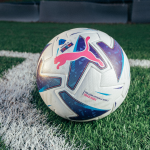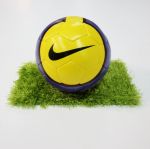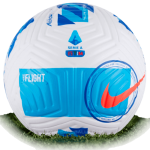
The new Serie A 2022 - 23: the history of the balls of the Italian league
From Nike to PUMA, how the aesthetics of the most popular sphere have changed
August 5th, 2022
The launch of a new ball is always very important at the beginning of a new season, it has always been the object that most evokes dreams and memories in each of us, and one of the most surprising novelties of this new and exciting season is certainly the debut of PUMA. After 15 years, the Italian Lega has put an end to the historic relationship with Nike, a binomial between the top Italian league and the American brand that has marked a generation of footballers, fans and supporters. The relationship between the Swoosh and Serie A has been far more important than is generally believed as it was able to unify the whole of Italy, as before in fact each team played at home with the ball of its technical sponsor.
This year the design has been heavily modified, the new PUMA ORBITA Serie A ball offers a unique configuration of 12 large star-shaped panels that results in a reduced number of seams, allowing for a better connection to the ball. The FIFA Approved ORBITA uses cutting-edge technology to create an optimal ball that retains its shape and allows for less water absorption. POE foam is added to increase touch sensitivity, providing a firmer feel and better rebound consistency. The ball also features a rubber bladder and a PAL (PUMA Air Lock) valve for optimal air retention and rebound.
Before PUMA came into the picture, however, as mentioned, Nike wrote important pages in this league. Up to the latest Flight Ball, the swoosh has spent a good eight years researching and experimenting; we are talking about the most innovative product ever created with regard to footballs. A model that has not only remained confined to Italy and has also been used in the Premier League.
Where it all started - T90
Before creating the latest Flight Ball, it took Nike a good eight years of research and experimentation to arrive at the most innovative product ever created in terms of footballs. It all started with the iconic model that takes its name, inspiration and design from one of the swoosh's most iconic templates. The T90's debut as a ball came in 2004, when clubs were still free to use any ball. From its debut until 2008 there were 3 models of Nike Total90 Aerow (I, II and III), then from the following season the naming also changed, becoming first Total90 Omni, then Total90 Ascente, Tota90 Tracer and finally Total90 Seitiro in 2011/2012. In these eight years we have witnessed a structural change of the ball, where we find the eternal conflict between the American brand and the three-stripes brand: the former has aimed at a purely aesthetic turning point by creating futuristic designs for each new ball, while the latter has focused on the nostalgic side, repeating the same aesthetics for years but introducing improvements in terms of materials.
Nike Maxim - 2012/2013
In 2012 Nike returned to the classic 30 panels (after slightly experimenting with pentagon shapes, trying to make them look like rims) for their balls, which in the meantime were seen on the pitches of all the major European leagues. The main difference lies in the colours: in each league the colourway is adapted according to national references. A model, however, that would not go beyond one season, with the swoosh returning a few months later to change the aesthetics and technology of its balls.
Nike Incyte - 2013/2014
The 'Incyte', too, unfortunately did not have much luck and, like the previous model, was only used for one season, finally paving the way for the Ordem, one of the last and revolutionary balls created by the Swoosh for Italy and England. To tell the truth, even its design did not exactly go down in history, soon slipping into oblivion.
Nike Ordem - 2014/2018
After Incyte comes the turning point. While adidas commands foreign competitions such as World Cups, EURO, Champions and all other European club tournaments, with Ordem the US brand scores a major coup. In addition to being one of the most tested balls, the Nike Ordem was equipped with a unique structure that ensured optimal pressure distribution, as well as Aerotrac technology that helped ensure a perfect flight line. There has also been a change in terms of graphics, with each element made in 3D to ensure optimal grip and create a visual effect that makes it easier for footballers to see it immediately.
Nike Merlin - 2018/2020
The new Swoosh product is the first to incorporate ACC technology, which will allow optimal touch and control in all weather conditions. Nike has reduced the structure panels from 12 to 4, expanding the striking surface area. The latex inner tube is wrapped in patented materials to promote more consistent air pressure and maintain shape. Secondary and tertiary colours serve to catch players' eyes and help them identify spin, speed and trajectory as quickly as possible. A model that was produced in the early 2000s and which in 2018 the Swoosh wanted to bring back before moving on to the Flight, with a design destined to change every control, pass or shot.
Nike Flight - 2020/2022
Technology has definitely invaded the field of play, changing fundamental aspects of the game invented by the English in the mid 1800s. Goal line technology, VAR, new tools to narrate football are all changing the most watched sport in the world. Within this evolution, suppliers such as Nike, for example, play a fundamental role. The swoosh to catch up with the league has created a new ball defined as game-changing football, one of those inventions that change the perception of the world. It took eight years of study, research and testing to arrive at the final product. A ball that, thanks to AerowSculpt's patented aerodynamic technology, has rewritten new pages of football and football physics. This new tech direction has allowed the ball to feel less aerodynamic effects when in the air and have 30% less oscillation than Nike's last balls.



























